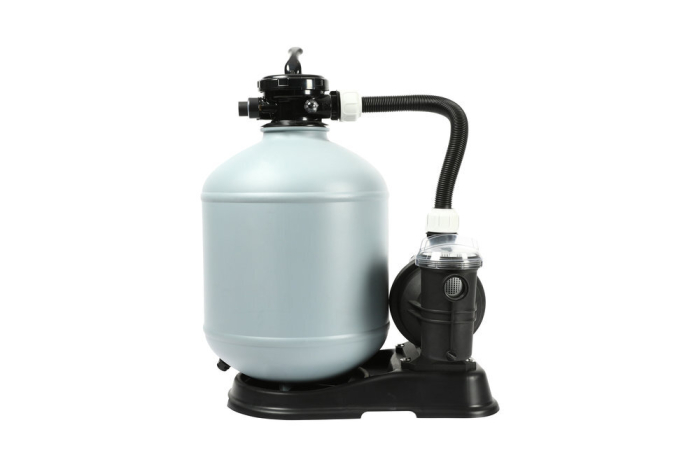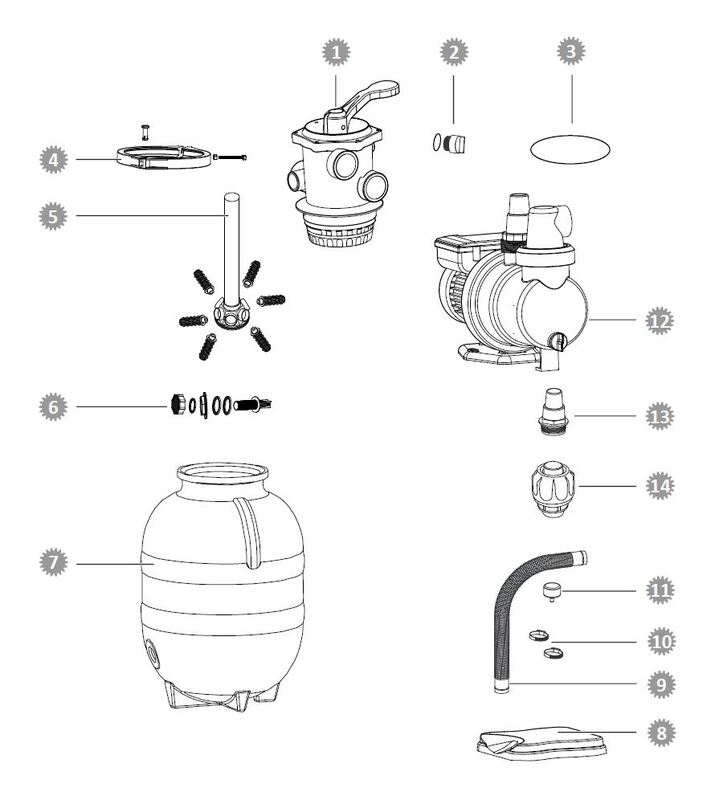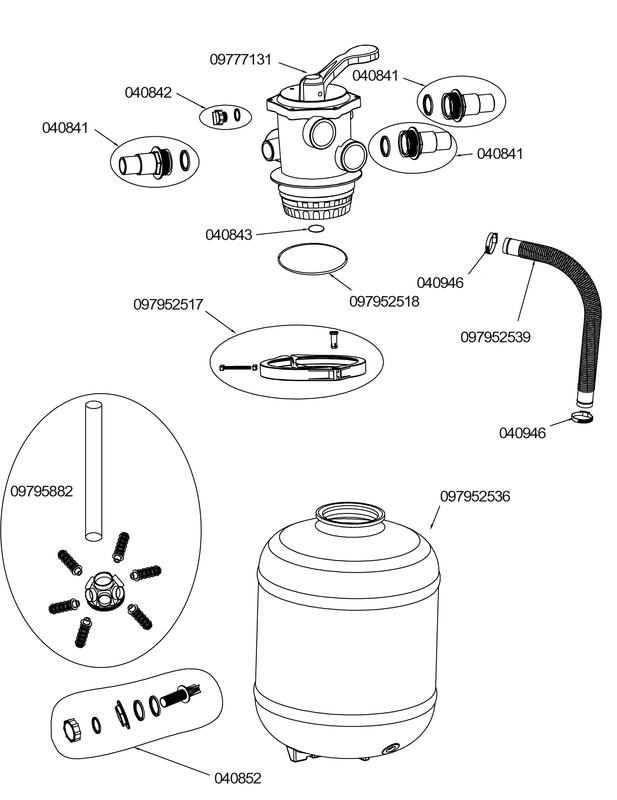Filter unit Eco Top 10
- Powerful filter unit for pools up to 65,000 l capacity
- 6-way valve with lever and manometer
Sold Out
The selected product is currently not available. As soon as the product is on stock, we will send you an E-mail.

Product information
The filter unit Eco Top 10 has a circulation capacity of 10.000 l/h, the connection is 220-240V~ / 50Hz /550 W. This filter unit can be used for pools with approx. 65.000 l water content and can be connected to all commercially available installation pools with a hose connection Ø 38 mm. The filter unit can be used up to a maximum water temperature of 35 °C. To maintain crystal-clear and sparkling pool water, the filter system can be operated with filter sand as well as with Filter Balls as filter medium.
Filter system:
Salt water suitable: yes
Water capacity: 65.000 l
Circulation capacity: 10.000 l/h
Boiler size: 476 mm
Connection size: Ø 38 mm
Valve type: 6-way valve with pressure gauge
Sound pressure level: < 70 dB(A)
Water temperature: 10°C - 35°C
Usable filter medium 1: filter sand
Quantity of filter medium 1 used: 75 kg
Sand grain size: 0,40 - 0,80 mm
Usable filter medium 2: Filter Balls
Quantity of usable filter medium 2: 2100 g
Pump part number: 041067
Filter pump:
Power supply: 220-240V~ / 50Hz
Input power maximum: 550 W
Transformer: no
Pump capacity: 14.000 l/h
Operating principle: self-priming
Head: 12,00 m
Pre-filter: yes
Timer present: no
Protection class: IPX5
Insulation class:
Cable length to unit: 5,00 m
FAQs from category Sand filter systems:
No, the filter system may only run when the pool is not in use. On the one hand, there is a risk of injury from the suction nozzle, on the other hand, dirt particles are swirled around during use, which the system cannot filter.
The filter system should circulate your pool water at least twice a day. Our Comfort 75 filter system, for example, manages approx. 8,000 litres per hour and can therefore completely circulate a pool with 19,000 litres once in just under 2.5 hours.
Check whether the seal (O-ring) is inserted correctly. If it is not placed with the nose in the groove of the vessel, the 7-way valve does not close properly and there is a higher distance between the 7-way valve and the vessel. Check whether the partition in the sand and clean water chamber area is correctly inserted in the sieve bottom. If not, the 7-way valve is also too high. Make sure that the seal at the top of the filter tank is in clean and perfect condition and that no sand is sticking to it. You can coat the O-ring with Vaseline. This serves to preserve the O-ring and additionally supports the sealing. Check that the 7-way valve is correctly fitted with the notch on the underside of the cover and the notch on the filter. Place the 7-way valve on the filter vessel, preferably with the help of a second person. Press the lid onto the filter bowl and make sure that the lid is flush with the vessel.
It is best to close the clamping ring with the help of a second person. A screw clamp can be used as an aid. The clamping ring must be tapped over the skeleton of the valve cover and vessel. If tapping with the palm of the hand is not enough, a rubber mallet can also be used. Start tapping at the back of the bolt and hit the tension ring evenly on the right and left until the ribbed pattern disappears. Then the clamping ring can also be easily closed with the bolt. The closure requires some force and must be a little stronger, as the vessel builds up pressure when used and must seal 100%. Do not use an ordinary hammer under any circumstances. Damage caused by this is not covered by the warranty or guarantee.
When filling the vessel with sand, check that the sieve bottom and the separating plate are correctly inserted. Before filling sand into the vessel, add approx. 20-30 cm of water to the vessel and fill the sand slowly to avoid damage due to the weight of the sand. Before the first filtering process, you must filter out the undersize particles of the sand. To do this, backwash for several minutes until clear water comes out of the backwash connection. If the sieve bottom or the separating plate are damaged, replace them. Please also observe the instructions for your filter system.
Fill the pump with water, loosen the transparent cover on the filter container (do not unscrew completely) to remove trapped air. Tighten the cover again when all air has escaped. Check all connections and hoses for leaks or holes. Retighten connections or hose clamps, seal with Teflon tape and replace the defective parts if necessary.
If the pressure in the boiler is too high, you must clean the filter bed (sand in the boiler) by backwashing. If filter balls are used, check them regularly for the degree of contamination and remove them from the vessel at regular intervals and wash them out. Clean the filter balls with a garden hose or in the bathtub. DO NOT BACKWASH WHEN USING FILTER BALLS! If the pressure in the vessel is too low, you must check the pre-filter for dirt and clean it so that sufficient water can flow into the pump. Check the water level and the height of the hanging skimmer; if the water level is too low, too little water will flow into the pump. Check the pressure gauge for damage. Clean the pressure line and empty the pre-filter basket. It could be that the suction line or the pre-filter basket are blocked. If the operating mode is set to "CLOSED", use another operating mode. It could be that the drain nozzle is closed. If this is the case, open it.
Depending on the grain size, the filter sand must be changed after three to five seasons.
Check your socket for power and test another socket if necessary. Never run the pump without water, the pump may run dry and burn out. Check the mains plug or the connection cable for damage. Check the running time of the external timer. Check the running time of the timer, if it is set.
Rust may have accumulated over the winter, which prevents the pump from starting or makes grinding noises when it is switched on. If the rust build-up is not too bad, this fault can be easily remedied. On most pumps, there is a small recess in the cover for ventilation, behind which there is a screw. Use a screwdriver to loosen the screw slightly and spray it with lubricant (e.g. WD40). If the rust has not settled too much, the pump will work again.
If you open the lever of the way valve valve during operation, the water will flow with pressure from all openings. The pressure drop may cause damage to the unit.
Remove the transport lock from the button cell battery. Check the battery and replace it if necessary. This does not apply to INTEX filter systems.
Remove the transport lock from the button cell battery. Set the external timer at the desired times and then plug the pump into the timer. Now start the integrated timer of the pump and set the time to 24 hours. The pump then starts at the times set on the external timer. This does not apply to INTEX filter systems.
Remove the transport lock from the button cell battery. If you do not remove these, the filter times will not be saved in the event of a power failure. Check the battery and replace it if necessary (Button cell lithium 3V CR2032).
With Intex sand filter systems, only the integrated timer works; an external timer cannot be connected due to the safety standards.
No, the red lights are not an error message. The lights on the timer are alternately green and red.
All Steinbach and INTEX filter systems (sand filter systems, cartridge filter systems & filter pumps) are suitable for salt water as long as the salt content in the water is below 0.5 % (salt electrolysis). Before winterising, clean the filter system thoroughly with standard bathroom cleaner, clear tap water and a lint-free cloth.
All filter systems and filter pumps have a sound pressure level* of < 70 dB(A).
*The emission volume is comparable to a large household appliance.
If the pressure is too low, the pre-filter is dirty and the pump is not getting enough water. Clean the pre-filter and check the suction line and the water level.
If the sand is newly filled in, or the sand is already very fine due to the use of several seasons, small sand particles may still be present. The solution is to backwash several times until the water comes out clear, or to fill in new sand.
The filter system should always be the first part in the water treatment system. The rest of the pool accessoires should only be connected after the filter system. A heat pump should ideally always be the last part in the water treatment system, so that the filtered, treated water flows through the heat pump and the path of the heated water into the pool is as short as possible.

















